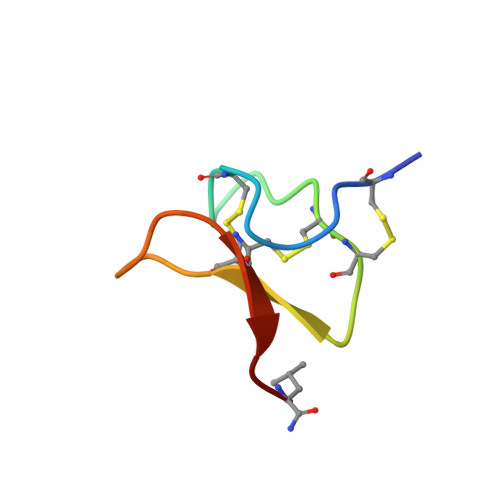Gating modifier toxins isolated from spider venom: Modulation of voltage-gated sodium channels and the role of lipid membranes.
Agwa, A.J., Peigneur, S., Chow, C.Y., Lawrence, N., Craik, D.J., Tytgat, J., King, G.F., Henriques, S.T., Schroeder, C.I.(2018) J Biol Chem 293: 9041-9052
- PubMed: 29703751
- DOI: https://doi.org/10.1074/jbc.RA118.002553
- Primary Citation of Related Structures:
6BR0, 6BTV - PubMed Abstract:
Gating modifier toxins (GMTs) are venom-derived peptides isolated from spiders and other venomous creatures and modulate activity of disease-relevant voltage-gated ion channels and are therefore being pursued as therapeutic leads. The amphipathic surface profile of GMTs has prompted the proposal that some GMTs simultaneously bind to the cell membrane and voltage-gated ion channels in a trimolecular complex. Here, we examined whether there is a relationship among spider GMT amphipathicity, membrane binding, and potency or selectivity for voltage-gated sodium (Na V ) channels. We used NMR spectroscopy and in silico calculations to examine the structures and physicochemical properties of a panel of nine GMTs and deployed surface plasmon resonance to measure GMT affinity for lipids putatively found in proximity to Na V channels. Electrophysiology was used to quantify GMT activity on Na V 1.7, an ion channel linked to chronic pain. Selectivity of the peptides was further examined against a panel of Na V channel subtypes. We show that GMTs adsorb to the outer leaflet of anionic lipid bilayers through electrostatic interactions. We did not observe a direct correlation between GMT amphipathicity and affinity for lipid bilayers. Furthermore, GMT-lipid bilayer interactions did not correlate with potency or selectivity for Na V s. We therefore propose that increased membrane binding is unlikely to improve subtype selectivity and that the conserved amphipathic GMT surface profile is an adaptation that facilitates simultaneous modulation of multiple Na V s.
Organizational Affiliation:
From the Institute for Molecular Bioscience, University of Queensland, Brisbane, Queensland 4072, Australia and.














